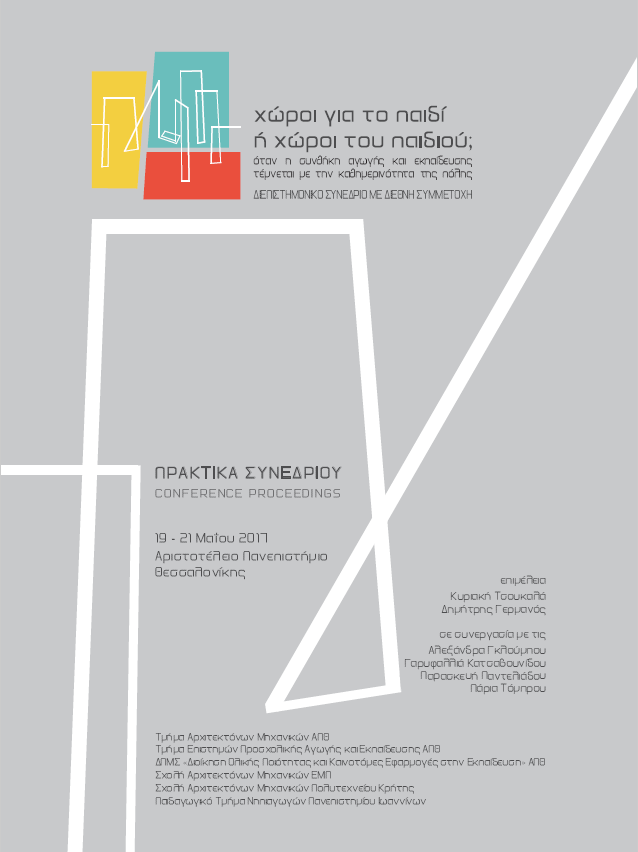Σχολική τάξη: Πώς ο χώρος μπορεί να επηρεάσει τη μάθηση των μαθητών

Δημοσιευμένα:
Ιουλ 27, 2019
Λέξεις-κλειδιά:
πειράματα χώρος παιδί μάθηση έρευνα αναδιάρθρωση χώρου ομαδικότητα συνεργασία δημιουργικότητα
Περίληψη
Η οργάνωση του χώρου είναι αποφασιστικής σημασίας, καθώς η συμπεριφορά των ανθρώπων επηρεάζεται σημαντικά από το χώρο και τη διευθέτησή του, καθώς και από τα αντικείμενα που υπάρχουν σε αυτόν (Κουτσουβάνου 1990). Ακόμη, οι συχνές επαφές των παιδιών με την ομάδα των συνομηλίκων σε ένα οικείο περιβάλλον δημιουργούν κατάλληλο πλαίσιο για την ανάπτυξη διαπροσωπικών σχέσεων (Dunn 1988). O Rog (2001) διαπιστώνει ότι το κριτήριο για το σχεδιασμό του χώρου πρέπει να είναι οι στόχοι του αναλυτικού προγράμματος. Ο χώρος παίρνει το ρόλο ενός εκπαιδευτικού βοηθού ( Dudek 2005). Η μέθοδος η οποία θα χρησιμοποιηθεί είναι η αλλαγή συγκεκριμένων χωρικών χαρακτηριστικών, ακολουθεί η παρατήρηση και η καταγραφή της αλλαγής της συμπεριφοράς των παιδιών, βάσει της κλίμακας Likert, και τέλος, η εξαγωγή συμπερασμάτων. Αυτό περιλαμβάνει την παρατήρηση της συμπεριφοράς των μαθητών και τον τρόπο με τον οποίο αντιδρούν σε συγκεκριμένες συνθήκες. Αυτή η έρευνα βασίζεται στη διαφοροποίηση δύο ομάδων. Στην ομάδα ελέγχου όπου το μάθημα γίνεται χωρίς αλλαγές στο χώρο και στην πειραματική ομάδα όπου γίνονται αλλαγές στο χώρο. Τα αποτελέσματα της έρευνας αναφέρονται στη σύγκριση των βαθμολογιών ανάμεσα στην ομάδα ελέγχου και την πειραματική ομάδα με τη βοήθεια της κλίμακας Likert όπως προαναφέραμε.
Λεπτομέρειες άρθρου
- Ενότητα
- ΘΕΜΑΤΙΚΗ Ι Μετασχηματισμοί των σχολικών χώρων και εκπαιδευτική αλλαγή
Οι συγγραφείς των άρθρων που δημοσιεύονται διατηρούν τα δικαιώματα πνευματικής ιδιοκτησίας επί των άρθρων τους, δίνοντας το δικαίωμα της πρώτης δημοσίευσης.
Άρθρα που δημοσιεύονται διατίθενται με άδεια Creative Commons 4.0 και σύμφωνα με την άδεια μπορούν να χρησιμοποιούνται ελεύθερα, με αναφορά στο/στη συγγραφέα και στην πρώτη δημοσίευση για μη κερδοσκοπικούς σκοπούς.
Οι συγγραφείς μπορούν να καταθέσουν το άρθρο σε ιδρυματικό ή άλλο αποθετήριο ή/και να το δημοσιεύσουν σε άλλη έκδοση, με υποχρεωτική την αναφορά πρώτης δημοσίευσης στα πρακτικά.
Οι συγγραφείς ενθαρρύνονται να καταθέσουν σε αποθετήριο ή να δημοσιεύσουν την εργασία τους στο διαδίκτυο πριν ή κατά τη διαδικασία υποβολής και αξιολόγησής της.
Αναφορές
Γερμανός, Δ. και Κανατσούλη, Μ. (επιμ.) (2010). ΤΕΠΑΕ 09. Πρακτικά επιστημονικών εκδηλώσεων του ΤΕΠΑΕ ΑΠΘ, 2007-09. Θεσσαλονίκη: ΑΠΘ/University Studio Press.
Γουργιώτου, Ε. και Ουγγρίνης, Κ.-Α. (2015). Αρχιτεκτονικές και εκπαιδευτικές παρεμβάσεις για τη δημιουργία τόπων μάθησης στο νηπιαγωγείο. Αθήνα: Δίσιγμα.
Κουτσουβάνου. Ε., (1996). Μορφές και τρόποι εργασίας στο νηπιαγωγείο. Αθήνα: Οδυσσέας.
Ουγγρίνης, Κ.-Α. (2012). Μεταβαλλόμενη αρχιτεκτονική. Κίνηση, προσαρμογή, ευελιξία. Αθήνα: Εκδόσεις Ίων.
Τσεβρένη, Ι., Πανταζής, Β., Τούση, Ε., και Παναγιωτάτου, Ε. (2008). Μεγαλώνοντας στην Αθήνα. Ένα πρόγραμμα περιβαλλοντικής Εκπαίδευσης για τη συμμετοχή των παιδιών στη διαμόρφωση του περιβάλλοντος τους. Αθήνα: Κοινωφελές Ίδρυμα Ι.Σ. Λάτσης/ΕΜΠ.
Bronfenbrenner, U. (1979). The ecology of human development Q Experiments in nature and design. Cambridge, MA: Harvard University Press.
Dudek, M. (2005). Children’s spaces. Oxford: The Architectural Press.
Dunn, J. (1988). The beginnings of social understanding. Oxford: Basik Blackwell Ltd.
Montessori, M. (1965). Dr. Montessori’s own handbook. New York: Schocken Books.
Piaget, J. (1951). The psychology of intelligence. London: Routledge and Kegan Paul Ltd.
Rog, J. (2001). Early literacy instruction in Kindergarten. USA: International reading association.
Shah. P. και Miyake, A. (επιμ.) (2005). The Cambridge handbook of visuospatial thinking. UK: Cambridge University Press.
Wake, S. (2007). Children’s gardens: Answering the call of the child? Στο Built Environment 33 (4): 83.
Zimmerman, M. A. (1995). Psychological empowerment: Issues and illustrations. Στο American Journal of Community Psychology 25(5): 581-59.


